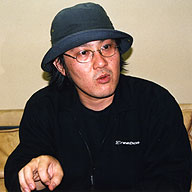An Interview with Uchida Nobuteru
The Tiniest Glimpse of Myself
Q: How many years did you spend on the filming?
UN: I spent two and a half years. I thought of Nabeyama’s Picture Letter solo exhibition as a vague goal. He had said he wanted to do a solo exhibition so I recommended that he definitely go ahead, and in the middle of the filming I touched on the exhibition as foreshadowing for the film. Another thing was to make the piece before Nabeyama turned thirty. It usually takes around two years, so I wanted him to do the exhibition before he turned thirty.

Q: Please tell us about Picture Letter.
UN: Nabeyama was probably drawing since around junior high school. I think of Picture Letter as an extension of drawing illustrations on postcards and sending them out as New Year’s cards, and he’d been doing this very seriously for a long time.
Shooting things with video and still cameras, we capture things just as they are, but I felt like Nabeyama uses his brush to capture the person’s nature. For example, even if the face isn’t a perfect resemblance, he’d depict their inner state, or some little gesture would resemble them. It was really interesting to me that people who had the drawings done were pleased because they were more real than photographs.
Q: In the piece, weren’t there any scenes where you appear?
UN: Nabeyama and Yoshitake who appeared in the film became pretty unstable emotionally and consulted with me as well, so there were situations where we exchanged opinions, and sometimes the camera was turned on me. But I thought it wasn’t necessary for me to state my own opinion in this work. I wanted to create the feeling of me there watching the two of them. In two and a half years I shot 160 tapes, so there are many other incidents that aren’t included in the film, and they are just so removed from the storyline, so during the editing I cut them all.
Q: Do the two families appear in the film?
UN: I didn’t film them. If I had more time, I might have filmed the families too…We started this before we turned thirty, and it was the kind of documentary where we didn’t know if it would finish or be successful. Our feelings were we didn’t want to bother our parents and have them get worried. Another thing is that I like narrative films, and in a narrative film you follow the main character and often you’ll get close to them even if their family doesn’t appear. Since it’s a documentary we see the flesh-and-blood person, but I wanted to create a piece that made you feel the family without showing the family.
Also, I didn’t want to follow the pattern used in a lot of documentaries recently, where the director comes out, cries and gets emotional. Overall, I was aiming for a documentary in the style of narrative film.
Q: How much time did you spend on the editing?
UN: One month. At first I was leisurely editing while working, but then Nabeyama said “This thing needs to be finished soon. What if you took time off from work and did the editing.” When I replied that I couldn’t take time off work, he said he’d pay for my living expenses. So I said “I’ll take a break” and I stopped working for a month and did the editing.
Q: Has anything changed since making Picture Letter?
UN: My works until now were fun to make, but nothing worth showing to other people…I felt like crying at the screening.
Also, after making Picture Letter I’ve been thinking I would like to make pieces other than for work. The environment for independent films has gotten into good shape, and I’d like to continue making films.
In the course of living people have good and bad times, but after two and a half years of filming, Nabeyama and I are in even slightly better circumstances, and I’ve had even the tiniest glimpse of myself.
(Compiled by Kurokawa Michiko)
Interviewers: Kurokawa Michiko, Okayasu Kenichi
Photography: Okayasu Kenichi / Video: Kato Takanobu / 2003-10-05 / in Tokyo
![]() Uchida Nobuteru’s website (Japanese)
Uchida Nobuteru’s website (Japanese)
